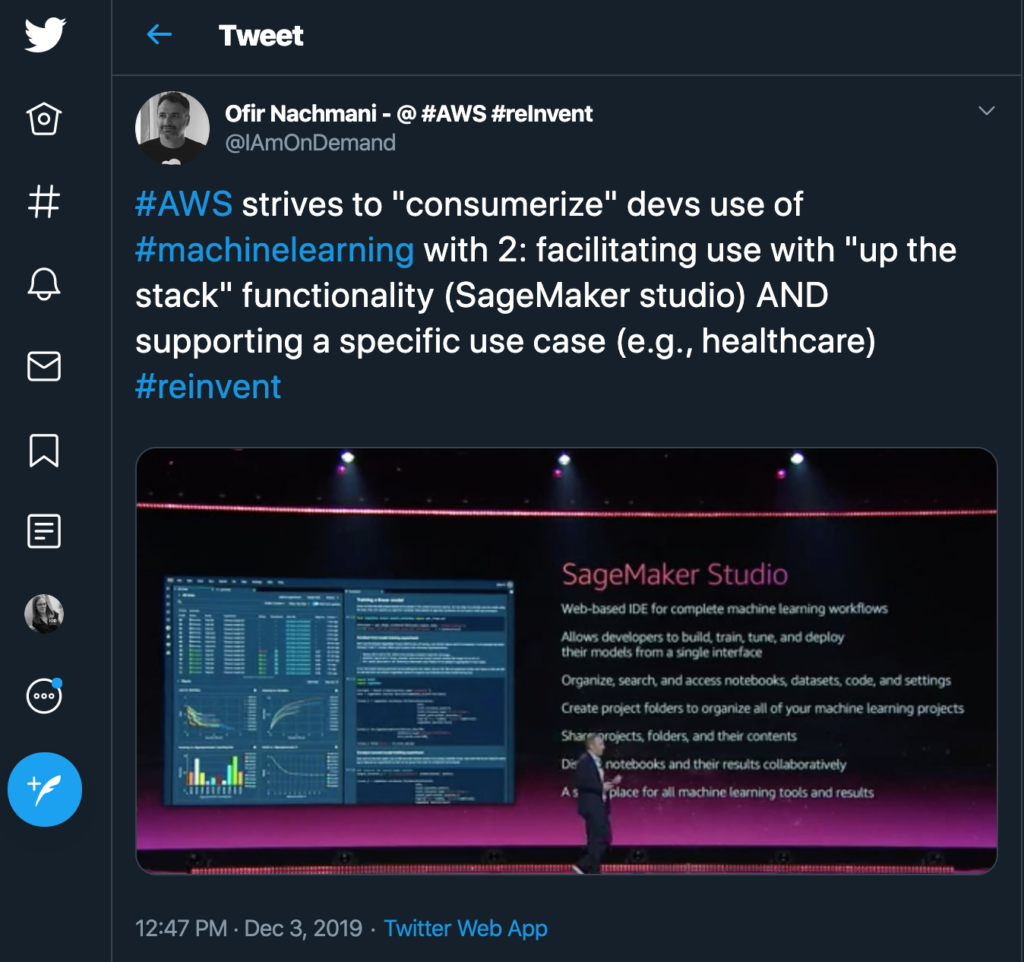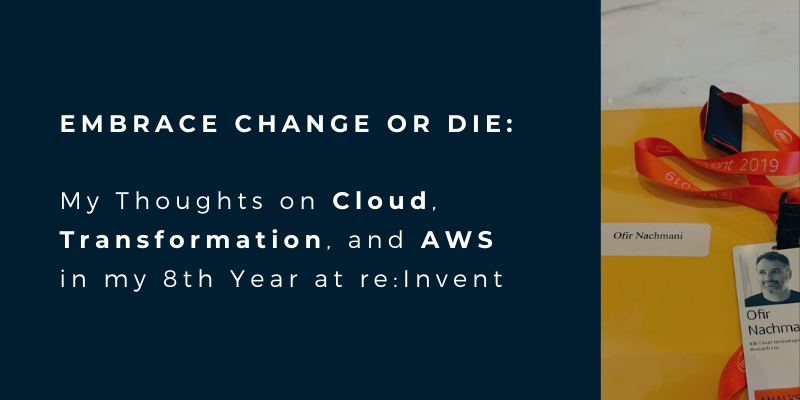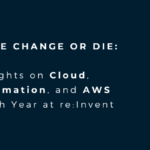If anyone in tech has the right to use the word “transformation,” it’s Amazon Web Services.
Now a $36 billion company with total profits of $8.8 billion over the last four quarters, AWS has 47.8 percent of the global market for public cloud Infrastructure as a Service (IaaS). A consistently innovative cloud industry leader, AWS has been shocking devotees with their announcements and product launches for more than 10 years. This is my own eighth AWS re:Invent — I’m joined here this week by 65,000 others — and I can tell you, this year’s excitement is no different.
Yesterday, the cloud giant announced some of their latest wins from the corporate world: auto racing giant Formula One Group will be using AWS for their next generation race car (cool!) and Best Western Hotels & Resorts will be moving its infrastructure to AWS, “migrating all of its business-critical applications to AWS including its hotel reservation system, customer reward platform, and global contact centers, with plans to complete the migration of these applications from its existing data centers by the end of 2020.”
Those are definitely significant business (and PR) wins for AWS. Let me share with you a few more that I found particularly relevant.

Data, Data, Data Engineering
First of all, I loved the data-related announcements as these hold the business value I am looking to see. These announcements include the release of AQUA, an important update to Redshift, its data warehouse. AQUA (an acronym for advanced query accelerator) runs on Amazon S3 and brings compute to the storage layer. AWS CEO Andy Jassy also unveiled Amazon S3 Access Points, which will allow users to customize access permission rules for each application.
Alongside the data engineering news, there were some cool Machine Learning announcements Tuesday, too, showing how Amazon is striving to consumerize developer use with “up the stack” products such as Amazon Sagemaker Autopilot, as well as ML-based products like Amazon Kendra (a search service for enterprises.) And Amazon CodeGuru, if it will be embraced, can be a killer capability for dev organizations using AWS.
Looking ahead a few years, there is a good chance that compute as we know it (ignoring quantum, which is at a very early stage) will eventually be saturated. Data usage and management, however, will always be a challenge. It makes sense that cloud values around data will shape the future of information.

Localized Clouds in Boxes (or Clouds Anywhere)
On Tuesday we also learned that AWS Outposts – the AWS on-prem cloud product traditionally perceived as a “cloud in a box” and first announced last year — would now be generally available. AWS Outposts allows customers to run their applications in their own private data centers, “scaling out” to the AWS core cloud global regions.
Are you a marketing professional seeking alternatives to in-house tech content creation? Contact us and we’ll be happy to tell you more about the IOD solution.
Added to the above was the news that Amazon launched new AWS Local Zones, a “new type of AWS infrastructure deployment that brings select AWS services very close to a particular geographic area.” AWS Local Zones have local internet ingress and egress to reduce latency. They also support AWS Direct Connect, offering users the opportunity to route traffic over a private network connection. It’s like a mini AWS region.
Highly-demanding applications that are particularly sensitive to latency — gaming, 3D modeling, and Electronic Design Automation to name a few — will benefit. Read more about local zones in this blog post from AWS Tech Evangelist Jeff Barr.
Another new “AWS zone” relates to the announcement about the Amazon partnership with the telecom industry: the reveal of a Verizon partnership to launch AWS Wavelength was a big one. The new service will put the AWS platform “at the edge of the 5G network.” In other words, on the telecom company’s premises, closer to our devices, having the potential to deliver single-digit millisecond latencies to users.
Amazon also announced partnering with with other key telecom players, including KDDI and SK Telecom. I bet there were some telecom professionals in the audience and watching online with wide smiles, for good reason, listening to the Verizon CEO during the Jassy Keynote. If done right, this will be a key ingredient in securing the future of the telecom industry in the IT market.
To summarize these three announcements, I will say that those of us who have been tracking AWS for years now know that there were multiple startups and investment in building what we call a private cloud, whether it was Cloudscaling (acquired by Dell EMC) who developed an AWS-compatible private cloud based on open-source Openstack or any other AWS-compatible custom IaaS. All of these failed, though.
Today I can say that they just arrived too early, when the traditional enterprise market wasn’t yet ready for cloud. AWS is now showing signs of going (finally) with the “traditional enterprise flow” and the latter looking toward cloud. AWS will now be able to run anywhere in their core regions, in the enterprise data center, or even on-prem at telco premise.
So now that AWS can be deployed anywhere. Is it a good thing? It’s too early to tell.
Transformation, or the Message Behind the Announcements
Even a consistently successful company like AWS still faces challenges when it comes to growth and adoption. Jassy’s focus early in his keynote Tuesday morning on words like “transformation” and “leadership” was specifically tailored for the executives in the multi-trillion dollar Enterprise IT market still enmeshed in and committed to an on-prem system that they don’t see as “broken.” (So why fix it?)
Well, as Jassy implied at the end of his keynote: Embrace change or die.

What’s Getting in the Way of Change?
The issue is that with all the investment in cloud technologies — coming from businesses ranging from the financial sector (such as Goldman Sachs, whose head also briefly shared the stage with Jassy today) to the U.S. government (shh…we’re not mentioning the JEDI contract) — industry leaders from traditional markets are still hesitating to embrace the change.
How do we know? Cloud still only represents 5.6% of total IT spending and only 20% of enterprise workloads have moved to the cloud. It’s clear that enterprise executives are still hesitant to move away from their traditional methods and infrastructure.
Jassy’s main message this year is that cloud adoption is no longer a bottom up game led by frustrated developers needing ad-hoc, on-demand resources. These days, cloud adoption is, and should be, top down. I’ll add that this should consider the typical three pillars of enterprise cloud transformation to the cloud — cost, security, and hybrid IT environments. These are still critically important for large enterprises when considering migrating legacy environments to the public cloud.
In essence, senior leadership should be leading the effort with a strategy, investment, plan, ambitious goals, and acquired skills through structured training of their teams. Yes, the cloud computing market, in general, is flourishing and Gartner predictions indicate it will top $214 billion in 2019, but for this to include the enterprise organization, there must an embracing of modernization by the C-Suite.
Cloud to Foster Innovation Which In Turn Will Accelerate Transformation
Finally, as I see it, more important than trying to prove the business case for moving to the cloud on-prem workloads that are already working just fine (and won’t show any immediate ROI the traditional C-level exec can “touch”), better to push innovation in terms of data aggregation, consolidation, and analytics: building a data lake to help improve manufacturing lines, for example, or customer service.
My advice: Keep your finger on the pulse of the traditional enterprise and continue to help the IT pros who can’t get past the idea that “it works, now leave it alone.” Instead, show them how to get value out of “this cloud.”





